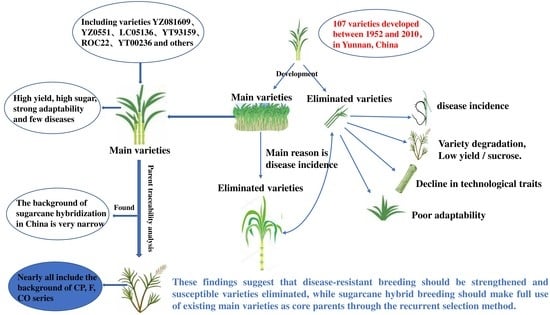Improvements in Sugarcane (Saccharum spp.) Varieties and Parent Traceability Analysis in Yunnan, China
Abstract
1. Introduction
2. Materials and Methods
2.1. Experimental Materials
2.2. Experimental Site and Test Design
2.3. Experimental Climate Conditions
2.4. Data Analysis
3. Results
3.1. Variation in Agronomic and Technological Characteristics among the 107 Varieties
3.2. Cluster Analysis
3.2.1. Cluster Analysis Based on the Agronomic and Industrial Characteristics
3.2.2. Differences in Agronomic and Industrial Characteristics among Cluster Groups
3.2.3. Differences in the Cultivated Area of the four Cluster Groups
3.3. Parent Traceability Analysis of the Main Cultivated Varieties (Group 1)
4. Discussion
4.1. Improvements in Sugarcane Varieties in Yunnan
4.2. Field Diseases Remain the Biggest Threat to Sugarcane Production in Yunnan
4.3. CP, F, and YC Series Germplasms Play an Important Role in Improving Sugarcane Varieties in Yunnan
4.4. Importance of Strengthening the Application of Main Existing Varieties as Core Hybrid Parents
5. Conclusions
Author Contributions
Funding
Data Availability Statement
Acknowledgments
Conflicts of Interest
Abbreviations
| CT | Chuantang variety |
| DZ | Dezhe variety |
| FN | Funong variety |
| GN | Gannan variety |
| GT | Guitang variety |
| GZ | Ganzhe variety |
| HN | Huanan variety |
| LC | Liucheng variety |
| MT | Mintang variety |
| ROC | Taiwan variety |
| YG | Yuegan variety |
| YT | Yuetang variety |
| YZ | Yunzhe variety |
References
- Roach, B.T. Origin and improvement of the genetic base of sugarcane. In Proceedings of the Australian Society of Sugar Cane Technologists, Annual Conference, Tweed Heads, Australia, 2–5 May 1989; Volume 11, pp. 34–47. [Google Scholar]
- Zhang, C.; Fu, C.; Hu, H.; Yang, Y. A summary review of sugarcane hybrid seed production in the seasons from 1999/2000 through 2008/2009 at Hainan sugarcane breeding station. Sugarcane Canesugar. 2009, 5, 1–5, 29. [Google Scholar] [CrossRef]
- Zhang, Q.; Zhang, C.; Chen, Y.; Deng, H. Pedigree analysis of genetic relationship among core parents of sugarcane in Mainland China. Guangdong Agric. Sci. 2009, 10, 44–48. [Google Scholar] [CrossRef]
- Chen, J.; Zhang, C.; Zhou, F.; Hu, H.; Hu, Y.; Xie, Y.; Wang, Q. Parent Analysis of New Sugarcane Varieties Developed in China from 2010 to 2020. Sugar Crops Chin. 2020, 3, 8–12. [Google Scholar] [CrossRef]
- Liang, Q.; Liu, X.; Li, Y.; Lin, Y.; Wang, Z.; Li, X.; Song, X.; Zhou, H.; Lin, S.; Li, Y. Growth and decline of sugarcane cultivar ROC22 in Guangxi sugarcane area from 2008 to 2017. Chin. J. Trop. Crops 2021, 42, 982–990. [Google Scholar] [CrossRef]
- Wu, C. Discussion on germplasm innovation and breeding breakthrough varieties in sugarcane. Southwest Chin. J. Agric. Sci. 2005, 18, 858–861. [Google Scholar] [CrossRef]
- Zhang, Y.; Wu, C. An enlightenment of Yunnan sugarcane varieties improvement enhancing seeping sugar ratio to Chinese sugarcane production. Sugar Crops Chin. 2016, 38, 71–73. [Google Scholar] [CrossRef]
- Deng, H.; Zhang, Q. Analysis on the parents of commercial varieties released in Mainland China in recent years. Guangdong Agric. Sci. 2006, 26, 7–10. [Google Scholar] [CrossRef]
- Dal-Bianco, M.; Carneiro, M.S.; Hotta, C.T.; Chapola, R.G.; Hoffmann, H.P.; Garcia, A.A.F.; Souza, G.M. Sugarcane improvement: How far can we go? Curr. Opin. Biotechnol. 2012, 23, 265–270. [Google Scholar] [CrossRef]
- Wu, J.; Wang, Q.; Wang, J.; Xie, J.; Pan, Y.; Zhou, F.; Guo, Y.; Chang, H.; Xu, H.; Zhang, W.; et al. SSR Marker-Assisted Management of Parental Germplasm in Sugarcane (Saccharum spp. hybrids) Breeding Programs. Agronomy 2019, 9, 449. [Google Scholar] [CrossRef]
- Snyman, S.J.; Meyer, G.M.; Koch, A.C.; Banasiak, M.; Watt, M.P. Applications of in vitro culture systems for commercial sugarcane production and improvement. In Vitro Cell. Dev. Biol.-Plant 2011, 47, 234–249. [Google Scholar] [CrossRef]
- Shabbir, R.; Javed, T.; Afzal, I.; Sabagh, A.E.; Ali, A.; Vicente, O.; Chen, P.H. Modern Biotechnologies: Innovative and Sustainable Approaches for the Improvement of Sugarcane Tolerance to Environmental Stresses. Agronomy 2021, 11, 1042. [Google Scholar] [CrossRef]
- Lingle, S.E.; Johnson, R.M.; Tew, T.L.; Viator, R.P. Changes in juice quality and sugarcane yield with recurrent selection for sucrose. Field Crop. Res. 2010, 118, 152–157. [Google Scholar] [CrossRef]
- Seema, Y.; Phillip, J.; Wei, X.M.; Elizabeth, M.R.; Karen, A.; Emily, D.; Felicity, A.; Ben, J.H.; Kai, P.V. Accelerating genetic gain in sugarcane breeding using genomic selection. Agronomy 2020, 10, 585. [Google Scholar] [CrossRef]
- Jackson, P.; McRae, T.A. Selection of sugarcane clones in small plots: Effects of plot size and selection criteria. Crop Sci. 2001, 41, 315–322. Available online: https://acsess.onlinelibrary.wiley.com/doi/pdf/10.2135/cropsci2001.412315x (accessed on 12 December 2021). [CrossRef]
- Zhou, H.; Yang, R.; Fang, F.; Li, Y. Principa component and cluster analyses for quantitative traits in GT sugarcane germplasm (Saccharum spp. Hybrids). J. Southwest Agric. 2012, 25, 390–395. [Google Scholar] [CrossRef]
- Zhao, Y.; Zhao, P.; Zhu, J.; Zhao, L.; Zan, F.; Yao, L.; Liu, J. Evaluation of 43 Australian sugarcane germplasm based on projection pursuit clustering. Subtrop. Agric. Res. 2019, 15, 7–13. [Google Scholar] [CrossRef]
- Zhao, D.; Comstock, J.C.; Glaz, B.; Edme, S.J.; Glynn, N.C.; Delblanco, I.A.; Gilbert, R.A.; Davidson, R.W.; Chen, C. Vigor rating and brix for first clonal selection stage of the canal point sugarcane cultivar development program. J. Crop Improv. 2012, 26, 60–75. [Google Scholar] [CrossRef]
- Zhao, Y.; Zhao, P.; Hu, X.; Zhao, J.; Zan, F.; Yao, L.; Zhao, L.; Yang, K.; Qin, W.; Xia, H.; et al. Evaluation of 317 sugarcane germplasm based on agronomic traits rating data. Chin. Agric. Sci. 2019, 52, 602–615. [Google Scholar] [CrossRef]
- Qi, Y.; Deng, H.; Li, Q. Advance in utilization of sugarcane germplasm in China mainland. Crop Res. 2012, 26, 443–446. [Google Scholar] [CrossRef]
- Ram, B.; Hemaprabha, G.; Singh, B.D.; Appunu, C. History and current status of sugarcane breeding, germplasm development and molecular biology in India. Sugar Tech. 2022, 24, 4–29. [Google Scholar] [CrossRef]
- Luo, J.; Xu, L.; Qiu, J.; Zhang, H.; Yuan, Z.; Deng, Z.; Chen, R.; Que, Y. Evaluation of sugarcane test environments and ecological zone division in China based on HA-GGE biplot. Acta Agron. Sin. 2015, 41, 214–227. [Google Scholar] [CrossRef]
- Liu, J.; Basnayake, J.; Jackson, P.A.; Chen, X.; Zhao, J.; Zhao, P.; Yang, L.; Bai, Y.; Xia, H.; Zan, F.; et al. Growth and yield of sugarcane genotypes are strongly correlated across irrigated and rainfed environments. Field Crop. Res. 2016, 196, 418–425. [Google Scholar] [CrossRef]
- Yang, R.; Zhou, H.; Tang, S.; Liu, X.; Liang, Q.; Huang, H. A few thoughts on sugarcane breeding in Guangxi. Sugar Crops Chin. 2021, 43, 18–27. [Google Scholar] [CrossRef]
- Sizuo, M.; Jesus, F.; Paulo, A. The Brazilian experience of sugarcane ethanol industry. In Vitro Cell. Dev. Biol.-Plant 2009, 45, 372–381. [Google Scholar] [CrossRef]
- Wei, X.; Eglinton, J.; Piperidis, G.; Atkin, F.; Morgan, T.; Parfitt, R.; Hu, F. Sugarcane breeding in Australia. Sugar Tech. 2022, 24, 151–165. [Google Scholar] [CrossRef]
- Zhao, D.; Li, Y. Climate change and sugarcane production: Potential impact and mitigation strategies. Int. J. Agron. 2015, 2015, 547386. [Google Scholar] [CrossRef]
- Jackson, P.A. Breeding for improved sugar content in sugarcane. Field Crop. Res. 2005, 92, 277–290. [Google Scholar] [CrossRef]
- Shan, H.; Cang, X.; Qin, W.; Li, W.; Wang, X.; Zhang, R.; Huang, Y. Resistance to pokkah boeng disease in new and main sugarcane varieties cultivated in China. Euphytica 2021, 217, 194. [Google Scholar] [CrossRef]
- Asinari, F.; Gómez, S.G.P.; Easdale, C.; Rago, A.M.; Balzarini, M.; Cafrune, E. Impact of yellow leaf virus on sugarcane commercial fields. Trop. Plant Pathol. 2021, 46, 37–43. [Google Scholar] [CrossRef]
- Viswanathan, R. Impact of yellow leaf disease in sugarcane and its successful disease management to sustain crop production. Indian Phytopathol. 2021, 74, 573–586. [Google Scholar] [CrossRef]
- Que, Y.; Xu, L.; Lin, J.; Chen, R. Molecular variation of sporisorium scitamineum in mainland China revealed by RAPD and SRAP Markers. Plant Dis. 2012, 96, 1519–1525. [Google Scholar] [CrossRef] [PubMed]
- Huang, Y.; Li, W.; Lu, W.; Luo, Z. The causes of sugarcane mosaic disease epidemic in Yunnan Sugarcane Area and the Control Strategy. J. Yunnan Agric. Univ. 2007, 22, 935–938. [Google Scholar] [CrossRef]
- Li, W.; Zhang, R.; Shan, H.; Wang, X.; Yin, J.; Luo, Z.; Li, J.; Cang, X.; Huang, Y. Occurrence and Epidemic Dynamics and Accurate Prevention and Control of Important Sugarcane Pests and Diseases in the Sugarcane Areas of Yunnan. Agric. Biotechnol. 2018, 7, 148–152. Available online: https://www.proquest.com/openview/8d9c8304b967b344935d4f1c6000d529/1?pq-origsite=gscholar&cbl=1596359 (accessed on 5 December 2021).
- Wang, X.; Li, W.; Huang, Y.; Zhang, R.; Luo, Z.; Shan, H.; Yin, J.; Shen, K.; Jia, Y.; Bai, Z. Analyses of the 16S-23S intergenic region of the phytoplasma causing the sugarcane white leaf disease in Yunnan Province, China. Trop. Plant Pathol. 2014, 39, 184–188. Available online: https://www.scielo.br/j/tpp/a/DgR93YLQTGmrHYJPFKZsdGP/?format=pdf&lang=en (accessed on 25 February 2022). [CrossRef][Green Version]
- Zhao, P.; Xia, H.; Liu, J.; Wu, C.; Zhao, J.; Yang, K.; Zan, F.; Chen, X.; Li, J.; Yao, L.; et al. Registration of ‘YZ081609′ Sugarcane. J. Plant Regist. 2019, 13, 362–367. [Google Scholar] [CrossRef]
- Wang, X.; Cang, X.; Qin, W.; Shan, H.; Zhang, R.; Wang, C.; Li, W.; Huang, Y. Evaluation of field resistance to brown stripe disease in novel and major cultivated sugarcane varieties in China. J. Plant Pathol. 2021, 103, 985–989. [Google Scholar] [CrossRef]
- Deng, H.; Li, Q.; Chen, Z. Breeding and utilization of new sugarcane parents. Sugarcane 2004, 11, 7–12. [Google Scholar]
- You, Q.; Pan, Y.; Xu, L.; Gao, S.; Wang, Q.; Su, Y.; Yang, Y.; Wu, Q.; Zhou, D.; Que, Y. Genetic diversity analysis of sugarcane germplasm based on fluorescencelabeled simple sequence repeat markers and a capillary electrophoresis-based genotyping platform. Sugar Tech. 2016, 18, 380–390. [Google Scholar] [CrossRef]
- Wu, J.; Wang, Q.; Pan, Y.; Xie, J.; Zhou, F.; Xu, H.; Qiu, Y.; Zhang, C.; Liu, Z. Multivariate analysis of 31 phenotypic traits among major parental lines of sugarcane breeding programs in China. J. Anim. Plant Sci. 2021, 31, 719–732. Available online: https://www.thejaps.org.pk/docs/2021/03/10.pdf (accessed on 15 March 2022).
- Ostengo, S.; Serino, G.; Perera, M.F.; Racedo, J.; Gonza’lez, S.Y.M.; Cornejo, F.Y.; Cuenya, M.I. Sugarcane breeding, germplasm development and supporting genetic research in Argentina. Sugar Tech. 2021, 24, 166–180. [Google Scholar] [CrossRef]
- Khumla, N.; Sakuanrungsirikul, S.; Punpee, P.; Hamarn, T.; Chaisan, T.; Soulard, L.; Songsri, P. Sugarcane Breeding, Germplasm Development and Supporting Genetics Research in Thailand. Sugar Tech. 2021, 24, 193–209. [Google Scholar] [CrossRef]
- Todd, J.; Glaz, B.; Burner, D.; Kimbeng, C. Historical Use of Cultivars as Parents in Florida and Louisiana Sugarcane Breeding Programs. Int. Scholarly Res. Not. 2015, 2015, 257417. [Google Scholar] [CrossRef] [PubMed]
- Nair, N.V.; Balakrishnan, R.; Sreenivasan, T.V. Variability for quantitative traits in exotic hybrid germplasm of sugarcane. Genet. Resour. Crop Evol. 1998, 45, 459–464. [Google Scholar] [CrossRef]
- Lingle, S.E.; Viator, R.P.; Johnson, R.M.; Tew, T.L.; Boykin, D.L. Recurrent selection for sucrose content has altered growth and sugar accumulation in sugarcane. Field Crop. Res. 2009, 113, 306–311. [Google Scholar] [CrossRef]
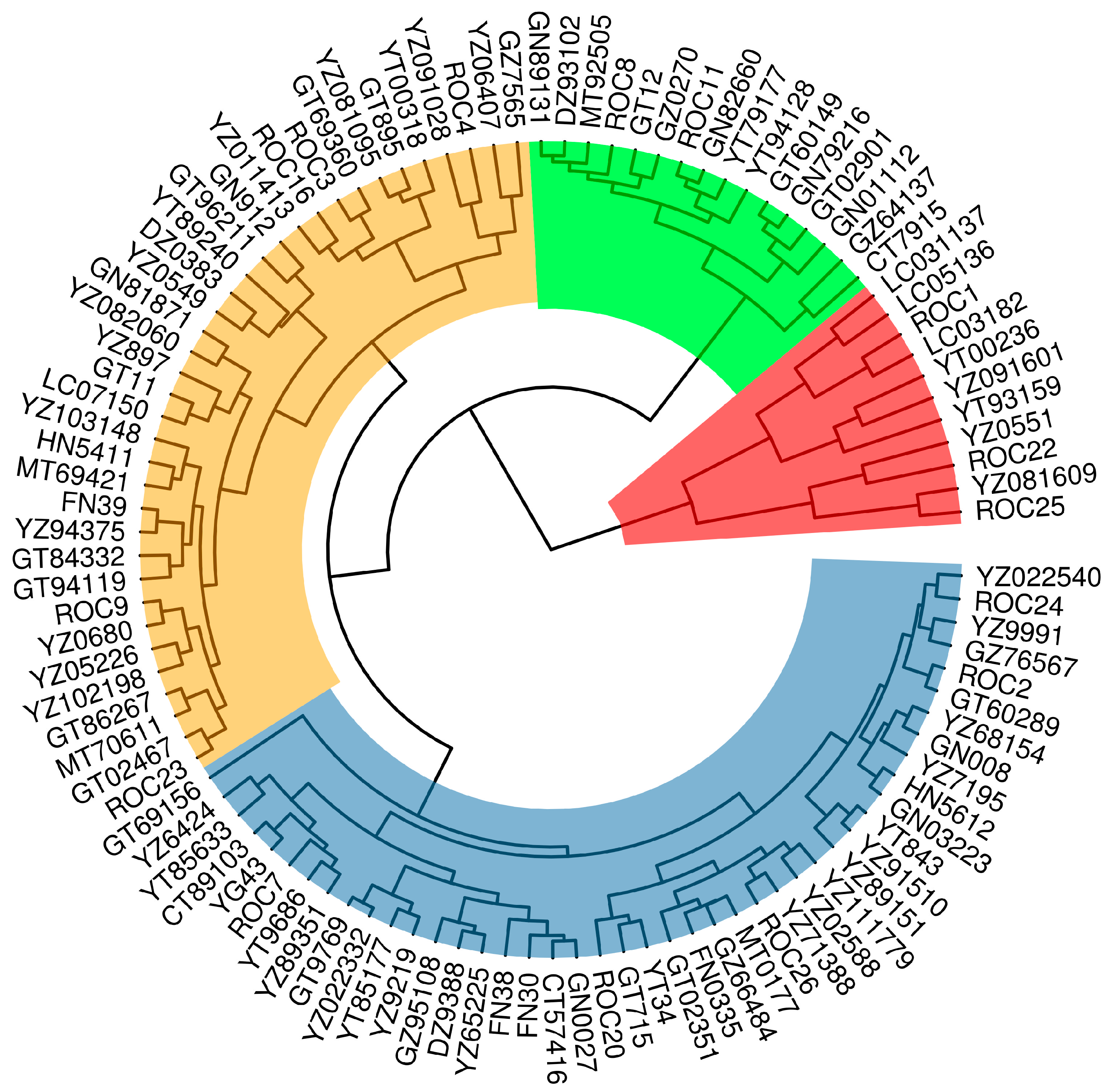
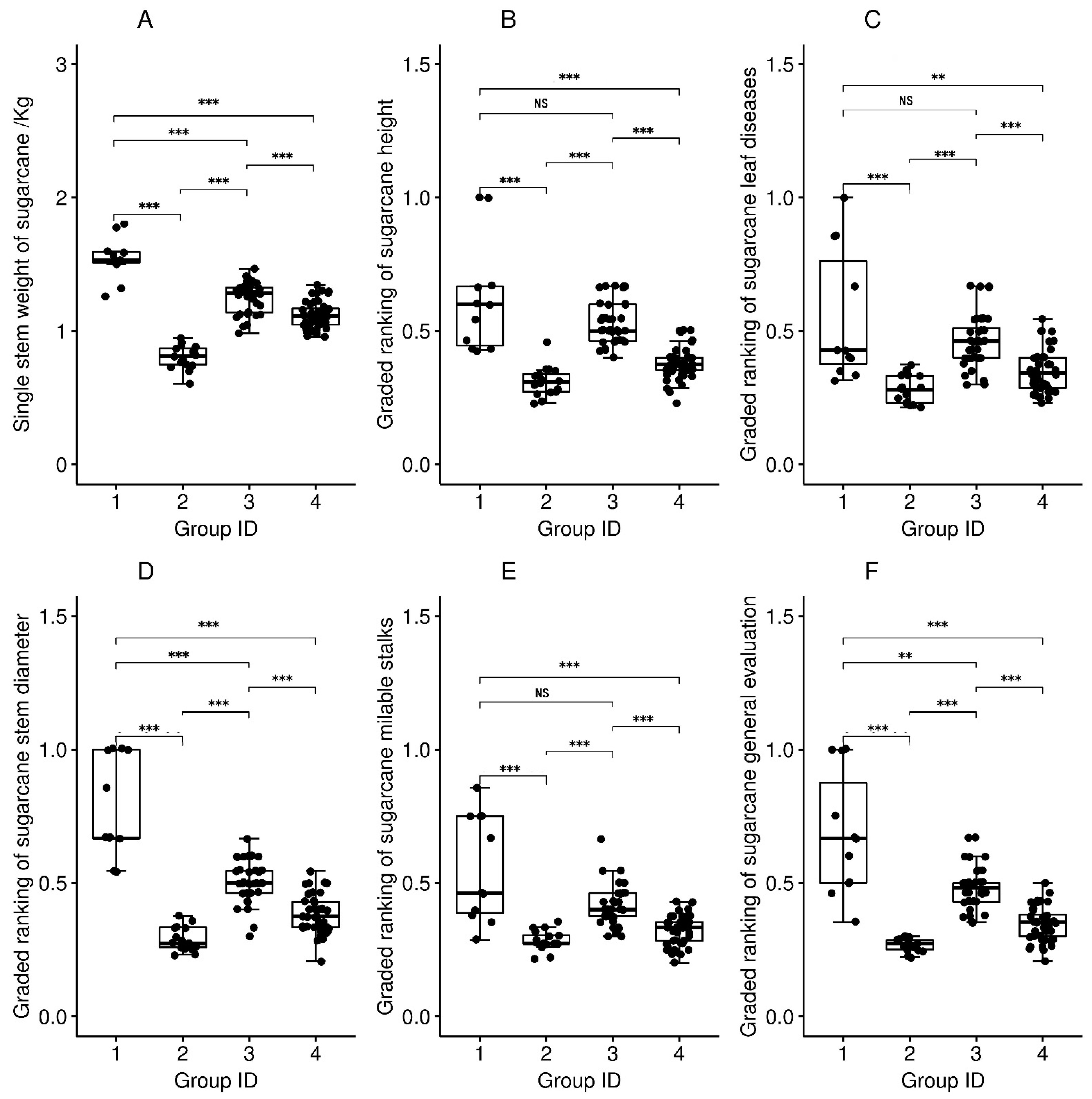

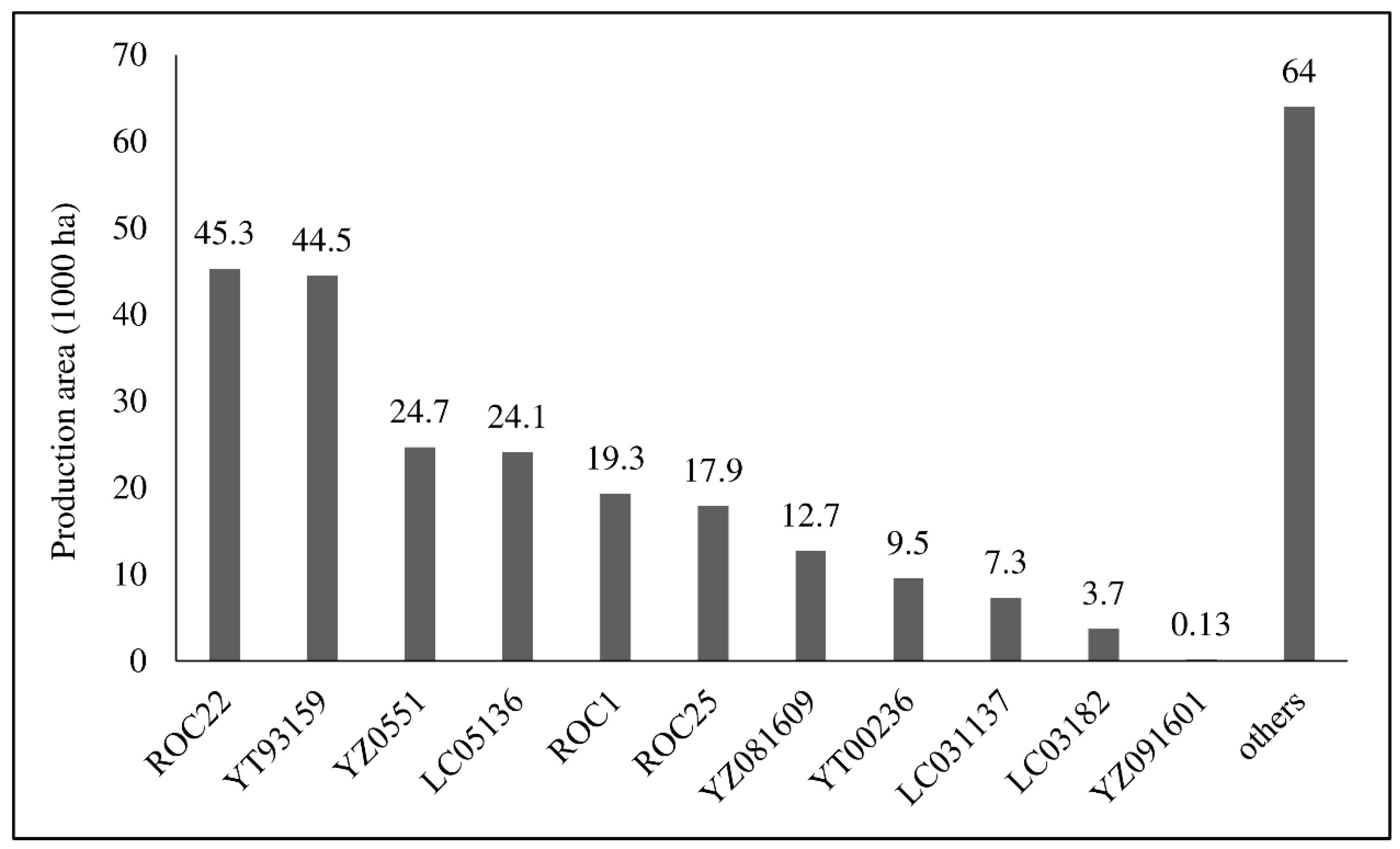
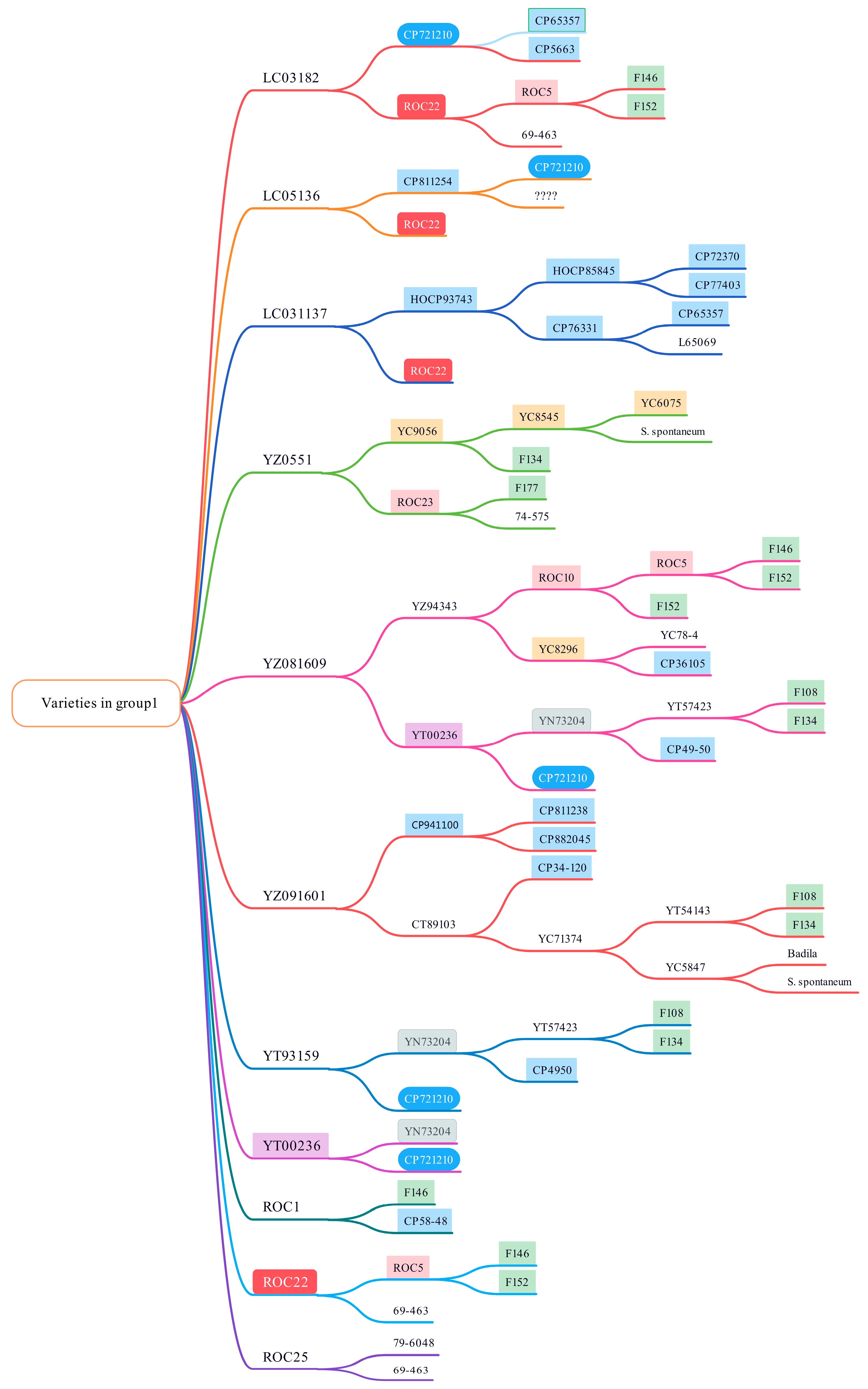
| Series * | Breeding Institution | No. of Varieties |
|---|---|---|
| YZ | Sugarcane Research Institute of Yunnan Academy of Agricultural Sciences | 29 |
| CT | Plant Engineering Research Institute of Sichuan Province | 3 |
| DZ | Sugarcane Research Institute of Dehong Prefecture, Yunnan Province | 3 |
| FN | Fujian Agriculture, and Forestry University | 4 |
| GZ, GN | Gannan Academy of Sciences | 15 |
| HN | Former South China Institute of Agricultural Sciences | 2 |
| LC | Guangxi Liucheng Institute of Agricultural Sciences | 4 |
| MT | Fujian Academy of Agricultural Sciences | 4 |
| YT, YG | Biological Engineering Institute of Guangdong Academy of Sciences | 12 |
| ROC | Materials imported from Taiwan, China | 15 |
| GT | Sugarcane Research Institute of Guangxi Academy of Agricultural Sciences | 16 |
| Rank * | Height (cm) | Stem Diameter (cm) | Millable Stalk Count (m2) | Incidence of Leaf Disease (%) | General Vigor |
|---|---|---|---|---|---|
| 1 | >280 | >3.00 | >10 | <5 | From vigorous (1) to weak (5) based on comprehensive observations of overall performance. |
| 2 | 220~280 | 2.5~3.00 | 8~10 | 5~10 | |
| 3 | 160~220 | 2.00~2.50 | 6~8 | 10~20 | |
| 4 | 100~160 | 1.50~2.00 | 4~5 | 20~30 | |
| 5 | <100 | <1.50 | <4 | >30 |
| Characteristic | Newly Planted | Ratoon 1 | Ratoon 2 | |||
|---|---|---|---|---|---|---|
| Mean | CV (%) | Mean | CV (%) | Mean | CV (%) | |
| Single-stem weight (kg) | 1.46 ** | 20.21 | 1.20 ** | 23.97 | 0.83 ** | 24.01 |
| Height | 2.28 ** | 36.47 | 2.66 ** | 38.82 | 2.37 ** | 35.36 |
| Stem diameter | 2.44 ** | 36.43 | 2.53 ** | 39.51 | 2.46 ** | 34.89 |
| Millable stalk count | 2.88 ** | 30.56 | 2.93 ** | 36.20 | 2.88 ** | 28.92 |
| Leaf disease incidence | 2.74 ** | 36.79 | 2.80 ** | 43.15 | 2.71 ** | 33.73 |
| General vigor | 2.66 ** | 38.23 | 2.79 ** | 37.74 | 2.58 ** | 36.74 |
| Characteristic | Newly Planted (%) | Ratoon 1 (%) | Ratoon 2 (%) | |||
|---|---|---|---|---|---|---|
| Mean | CV | Mean | CV = | Mean | CV | |
| Sugarcane brix | 21.34 ** | 6.92 | 21.75 ** | 5.93 | 22.47 ** | 6.05 |
| Juice sugar content | 18.41 ** | 9.43 | 18.82 ** | 7.69 | 19.64 ** | 7.95 |
| Cane sugar content | 14.78 ** | 9.21 | 15.00 ** | 7.18 | 15.65 ** | 7.16 |
| Gravity purity content | 84.63 ** | 4.82 | 86.27 ** | 3.53 | 87.31 ** | 3.47 |
| Cane fiber content | 13.38 ** | 13.04 | 15.09 ** | 12.13 | 15.26 ** | 12.53 |
Publisher’s Note: MDPI stays neutral with regard to jurisdictional claims in published maps and institutional affiliations. |
© 2022 by the authors. Licensee MDPI, Basel, Switzerland. This article is an open access article distributed under the terms and conditions of the Creative Commons Attribution (CC BY) license (https://creativecommons.org/licenses/by/4.0/).
Share and Cite
Zhao, Y.; Zan, F.; Deng, J.; Zhao, P.; Zhao, J.; Wu, C.; Liu, J.; Zhang, Y. Improvements in Sugarcane (Saccharum spp.) Varieties and Parent Traceability Analysis in Yunnan, China. Agronomy 2022, 12, 1211. https://doi.org/10.3390/agronomy12051211
Zhao Y, Zan F, Deng J, Zhao P, Zhao J, Wu C, Liu J, Zhang Y. Improvements in Sugarcane (Saccharum spp.) Varieties and Parent Traceability Analysis in Yunnan, China. Agronomy. 2022; 12(5):1211. https://doi.org/10.3390/agronomy12051211
Chicago/Turabian StyleZhao, Yong, Fenggang Zan, Jun Deng, Peifang Zhao, Jun Zhao, Caiwen Wu, Jiayong Liu, and Yuebin Zhang. 2022. "Improvements in Sugarcane (Saccharum spp.) Varieties and Parent Traceability Analysis in Yunnan, China" Agronomy 12, no. 5: 1211. https://doi.org/10.3390/agronomy12051211
APA StyleZhao, Y., Zan, F., Deng, J., Zhao, P., Zhao, J., Wu, C., Liu, J., & Zhang, Y. (2022). Improvements in Sugarcane (Saccharum spp.) Varieties and Parent Traceability Analysis in Yunnan, China. Agronomy, 12(5), 1211. https://doi.org/10.3390/agronomy12051211






